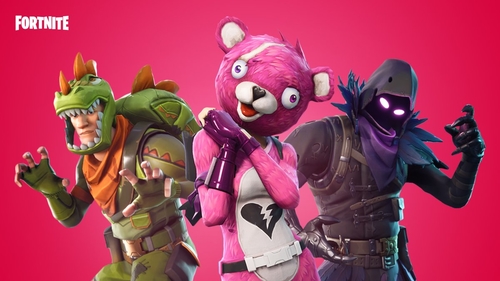It is one of the most popular video games in recent history, boasting 125 million worldwide users. Fortnite is a game that sees players fight as animated characters to be the last one standing. Players can play for free but upgrades such as character ‘skins’ (outfits) are bought or earned through hours of gaming. However, interestingly, there are other ways to obtain these upgrades.
‘Fortnite Propositions’
I recently observed that two brands had cleverly integrated their proposition with this hugely popular game.
Samsung, launching their latest phone, offered customers the opportunity to gain a ‘free’ and unique ‘skin’ (see below). This ‘skin’ has been dubbed the most expensive outfit on the game because it can only be unlocked by purchasing certain Samsung devices. Samsung are clearly using this cross-proposition offering as a differentiation strategy in order to target and attract new customers away from their competitors.
Amazon are also using Fortnite to entice customers into using their Twitch Prime service but have gone one step further by also attempting to drive loyalty through offering new ‘skins’ on an ongoing basis (see below).

I have been writing about what I call Customer Constellations, a means of creating positive customer connections with brands across the ‘customer universe’, for the past 6 months. I designed the framework to help insurers remedy the ‘low touch’ and low perception of value felt by many of their customers.
Here in this game of Fortnite, I saw two organisations creating positive customer touchpoints in a very innovative way. Perhaps more impressive was the fact that they had reacted so quickly to emerging customer trends – Fortnite launched in late July 2017 and in the space of a year has gained 125 million users (and potential customers).
Lessons for Insurance Execs
When insurers think about partnerships with third parties, they often think of the long-established distribution relationships with retail banks. Whilst this does have the benefit of creating a positive connection with a ‘high touch’ service and an industry that is ahead from a customer loyalty and experience perspective (see here), the relationship remains grounded in distributing an existing and unexciting product.
Now I am not necessarily suggesting that insurers should sponsor a ‘skin’ on Fortnite. The point of this article is to show that insurers need to begin looking at both non-traditional partners and partnership models. The retail & technology brands mentioned above are offering a glimpse of what is possible when you think outside of the box.
Thinking Outside of the Box – Building Your Own ‘Fortnite Proposition’
The key to building these positive connections or ‘constellations’ is to really Know Your Customers (KYC) and, following this, Know Your Partners (KYP).
When creating these ‘constellations’ it is important to ground yourself in data. A hunch in today’s world is not good enough, you need to have a sound business case in place that outlines the additional costs of engagement and the benefits. For example, Vitality Health spent £62.7MN on their ‘engaged’ proposition and discounts in 2017 but have benefited from lower loss ratios and higher customer engagement [1].
KYC – Know Your Customers
KYC, in this case, does not mean understanding your customers for Compliance purposes. It is about knowing:
- Who your most valuable (prospective) customers are
- What their interests are outside of financial services
- What proposition enhancements are likely to drive key business outcomes (increased new business, retention or additional product sales)
When supporting clients I often use a combination of internal customer segmentation data to help define the most valuable customers (point 1) and Grant Thornton’s Customer Loyalty & Experience Index (CLIX) data to determine the profile and drivers of the key business outcomes for brands outside of financial services (points 2 & 3).
The 2018 CLIX dataset includes over 24,000 customer responses to questions concerning 18 customer engagement metrics for 120 brands across the retail, technology, media and financial services sectors.
KYP – Know Your Partners
Once you have found the right services that your customers value, the aim is then to find the right partners to supply this service. The trick here is to ensure that your partner does not damage your current standing amongst existing customers and the perception of your brand with prospective customers. Therefore, it is always prudent to pick brands with similar or better customer loyalty and experience scores than your own.
Again, I use CLIX data to help me do this. In the diagram below, it is clear that Brand A should not partner with Brand B but should look for brands in the yellow-shaded area.

The End Result
Once you have determined the right services and partners, you can then move the customer relationship away from not only a pure price play but also away from insurance itself. Customers will then begin perceiving your brand as one that provides a multitude of rational benefits for them across their universe.
Insurance Industry Forerunners
Historically, insurers have struggled to engage with customers on a frequent basis because the traditional product and service has provided limited reasons to engage. However, the right partnership can remedy this by placing the insurer within the target customer’s daily routine.
We have seen insurers like Vitality integrate very well with everyday brands such as Apple, Ocado, Starbucks and even with the Amazon Echo. These integrations have proven attractive, with 65,000 Apple Watches and 330,000 monthly Starbucks being distributed through the proposition. Further, it appears to be a commercially beneficial model – Vitality reported 50% lower lapse rates for ‘engaged’ customers and a Health business loss ratio that has declined by 21% since 2013 [2].
Similarly, a number of the aggregators are also adding rewards such as meal vouchers and cinema tickets to their offerings to create another positive ‘constellation’ and differentiate themselves on grounds other than TV advertising and user friendly customer journeys.
These organisations and their strategies have been effective because they understand the customer universe outside of insurance and the services and brands that give their customers the greatest utility on a daily basis. However, customer interests and desires are not static, and these firms should ensure that they continuously scan the customer universe for emerging trends. Only by doing so can sustainable competitive advantage be achieved – how long will it really be until Fortnite numbers begin to decline as customers switch interest to new games?
Where Do I Start Building My Own ‘Fortnite Proposition’?
In order to develop a sustainable competitive advantage through their propositions, insurers need to have:
- A well-defined customer engagement strategy
- A framework for identifying potential ‘constellations’ – an Innovation Lab is a useful concept allowing you to:
- Systematically scan for emerging customer trends
- Simulate the impact of the proposed initiatives
- A means of assessing the impact of these initiatives on key customer and business metrics
If you would like to discuss this article in more detail, please do get in touch with me at samuel.c.church@uk.gt.com
Sources:
[1] Discovery Annual Report & Presentation 2017
[2] Discovery Annual Report & Presentation 2018
Image credit: Epic Games

Article by channel:
Everything you need to know about Digital Transformation
The best articles, news and events direct to your inbox
Read more articles tagged: Brand, Customer Journey, Featured, Loyalty







